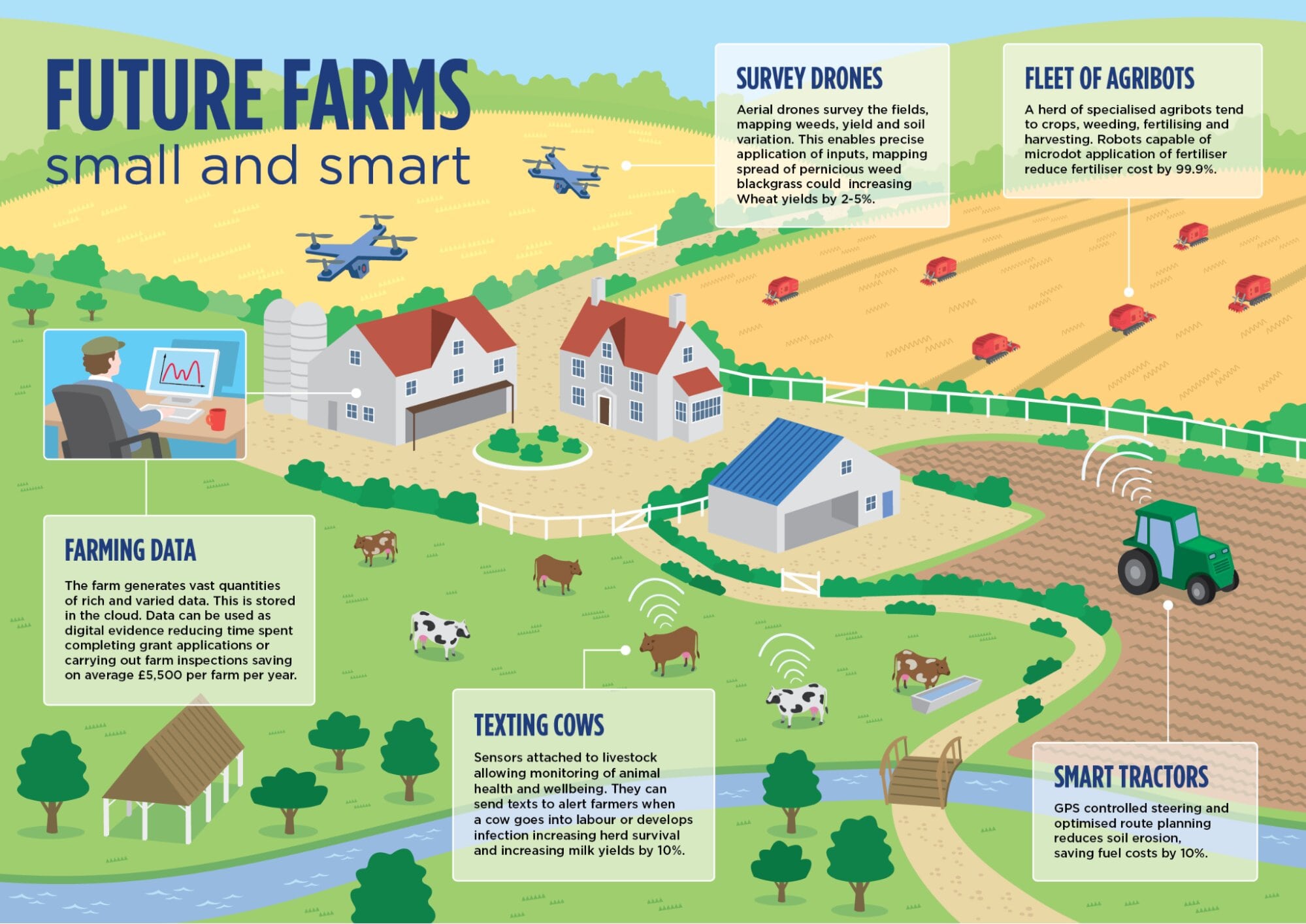Agriculture
Adoption of Modern Technology in Agriculture
- 04 Apr 2022
- 7 min read
For Prelims: IDEA, genetic engineering, artificial intelligence, block chain, remote sensing, GIS technology, use of drones, SMAM, Kisan Call Centres, Kisan Suvidha App, Agri Market App.
For Mains: E-Technology in the Aid of Farmers
Why in News?
Recently, the Union Minister of Agriculture and Farmers Welfare in a written reply in Rajya Sabha informed about the various initiatives taken by the government for adopting technology in Agriculture.
- In 2021, a consultation paper on the India Digital Ecosystem of Agriculture (IDEA) from the Ministry of Agriculture and Farmers’ Welfare (MoA&FW) was released, which talks about a digital revolution in the agriculture sector.
- The adoption of modern technology depends on various factors such as socioeconomic conditions, geographical conditions, crop grown, irrigation facilities etc.
What is the importance of Technology in Agriculture?
- Technology in agriculture can be used in different aspects of agriculture such as the application of herbicide, pesticide, fertilizer, and improved seed.
- Over the years, technology has proved to be extremely useful in the agricultural sector.
- Presently, farmers are able to grow crops in areas where they were thought could not grow, but this is only possible through agricultural biotechnology.
- For example, genetic engineering has made it possible to introduce certain strains into other genes of crops or animals.
- Such engineering boosts the resistance of the crops to pests (e.g. Bt Cotton) and droughts. Through technology, farmers are in a position to electrify every process for efficiency and improved production.
How using Technology can be Beneficial in Agriculture?
- Increases agriculture productivity.
- Prevents soil degradation.
- Reduces chemical application in crop production.
- Efficient use of water resources.
- Disseminates modern farm practices to improve the quality, quantity and reduced cost of production.
- Changes the socio-economic status of farmers.
What are the Related Challenges?
- Education and Training Related:
- Lack of knowledge
- Inadequate skills
- Lack of improved skills
- Technology and Infrastructure:
- Poor infrastructure
- Lack of storage
- Lack of transport
- Economic and Policy issues:
- Lack of Money
- Access to credit
- Lack of access to Bank Loans
- Climate and Environmental Issues:
- Poor soils,
- Soil fertility
- Unreliable rainfall
- Natural disasters such as floods, frost, hail storm
- Psycho-Social Issues:
- Workers have no interest in agriculture, Farm works are not preferred over ipelegeng projects (self-reliance works), Farm jobs are time consuming.
What are the Steps taken by the Government in the Direction?
- AgriStack: The Ministry of Agriculture and Farmers Welfare has planned creating ‘AgriStack’ - a collection of technology-based interventions in agriculture.
- Digital Agriculture Mission: This has been initiated for 2021 -2025 by the government for projects based on new technologies like artificial intelligence, block chain, remote sensing and GIS technology, use of drones and robots etc.
- Unified Farmer Service Platform (UFSP): UFSP is a combination of Core Infrastructure, Data, Applications and Tools that enable seamless interoperability of various public and private IT systems in the agriculture ecosystem across the country.
- National e-Governance Plan in Agriculture (NeGP-A): A Centrally Sponsored Scheme, it was initially launched in 2010-11 in 7 pilot States, which aims to achieve rapid development in India through use of ICT for timely access to agriculture related information to the farmers.
- In 2014-15, the scheme was further extended for all the remaining States and 2 UTs.
- Sub-Mission on Agricultural Mechanization (SMAM):
- Under this Scheme, subsidies are provided for purchase of various types of agricultural equipment and machinery.
- Other Digital Initiatives: Kisan Call Centres, Kisan Suvidha App, Agri Market App, Soil Health Card (SHC) Portal, etc.
Way Forward
- The use of technology has defined the 21st century. As the world moves toward quantum computing, AI, big data, and other new technologies, India has a tremendous opportunity to reap the advantage of being an IT giant and revolutionize the farming sector. While the green revolution led to an increase in agricultural production, the IT revolution in Indian farming must be the next big step.
- There need to be immense efforts to improve the capacities of the farmers in India – at least until the educated young farmers replace the existing under-educated small and medium farmers.
- Technology in agriculture has the potential to truly lead India to be “Atmanirbhar Bharat” in all respects, and be less dependent on extraneous factors.
UPSC Civil Services Examination, Previous Year Questions (PYQs)
Q. Consider the following statements: (2017)
The nation-wide ‘Soil Health Card Scheme’ aims at
- expanding the cultivable area under irrigation.
- enabling the banks to assess the quantum of loans to be granted to farmers on the basis of soil quality.
- checking the overuse of fertilizers in farmlands.
Which of the above statements is/are correct?
(a) 1 and 2 only
(b) 3 only
(c) 2 and 3 only
(d) 1, 2 and 3
Ans: (b)
- Soil Health Card (SHC) is a GoI scheme promoted by the Department of Agriculture and Co-operation under the Ministry of Agriculture and Farmers’ Welfare. It is being implemented through the Department of Agriculture of all the State and Union Territory Governments.
- A SHC is meant to give each farmer, soil nutrient status of the holding and advise on the dosage of fertilizers and also the needed soil amendments, that should be applied to maintain soil health in the long run.
- The main aim behind the scheme is to find out the type of a particular soil and then provide ways in which farmers can improve it.







